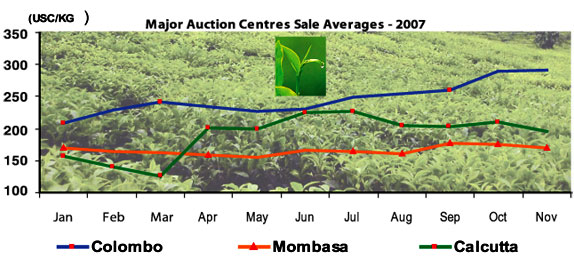Market prospects for Ceylon tea in 2008 'optimistic' - Report
The market prospects for Ceylon tea in 2008 look optimistic said Asia
Siyaka Commodities (Pvt) Ltd in its annual report 2008.
Local and global factors would play a part in a year full of
opportunities as well as some uncertainties.
 Low Grown teas, together with whole and semi leaf grades from other
elevations will enjoy good marketing conditions throughout 2008. Price
levels set in 2007 should hold, other than during high producing period
of Q2 when we could see comparatively lower prices if the production
surge does take place. Low Grown teas, together with whole and semi leaf grades from other
elevations will enjoy good marketing conditions throughout 2008. Price
levels set in 2007 should hold, other than during high producing period
of Q2 when we could see comparatively lower prices if the production
surge does take place.
Small leaf grades from higher elevations too should follow a similar
pattern. In this instance, however, external factors may influence
prices even during rush months of Q2, the report said.
On the positive side, Sri Lanka's main tea export markets in the
Middle East and North Africa (53%) and Russia and CIS (23%) are all
likely to enjoy relative economic stability as oil prices would remain
strong in the year that economists forecast recession. Also tea is a
part of the basic food basket for many families in these countries.
The liberalisation of tea markets such as Iran, Libya and Iraq will
add demand. Even Russia who has its sights on entry to the WTO in 2008
has been compelled to reduce its import duties to the advantage of
producer nations.
Sri Lanka is the largest supplier of tea to this market and was
granted duty free access for Bulk Tea shipments.
Problems in Kenya will definitely have an impact on global supply
during Q1, 2008. Long-term implications will unfold in Q2 and Q3. Kenya
could have problems with seasonal dry conditions as well, if they extend
beyond Q1. Kenyan quality will also be compromised due to instability.
Food prices have risen around the world, enabling marketers to
increase prices. Prices once increased do not easily come down. Packers
should therefore be able to at least hold 2007 tea purchase prices.
India's domestic consumption continues strong and exports have been
below the 200 million kg mark since the year 2000.
 It was only in 2006 that 203 million kg was shipped (including
imported tea re-exported). It was only in 2006 that 203 million kg was shipped (including
imported tea re-exported).
Judging from preliminary data released to November 2007, export
volume is likely to be in the region of 175 million kg.
Serious droughts have-not been forecast in producer countries, but
Kenya's Q1 weather is exceptionally dry.
Sri Lanka too will have a dry low producing Q1 while North India and
Vietnam will be in winter during this period.
China the biggest global Green Tea supplier has been stocking up for
the Olympics. Their have also been reports of crop loss caused by the
sever winter. On the negative side, rising costs could affect
agricultural inputs and slow a Sri Lankan production recovery.
The smallholder sector as well as plantation companies will face
rising fertiliser and wage bills.
Sri Lanka cannot afford another strike in the plantation sector and
further damage our reputation as a reliable supplier.
The negative fall out would have a long term impact not just on the
Companies but workers themselves and the industry on the whole.
Another year of crop loss would compel hitherto loyal customers to
seek alternative sources of supply.
The Indian Central Government has been pumping in money to subsidise
conversion to orthodox manufacture.
Simultaneously, India has budgeted for substantial promotional
expenditure in Russia. |
